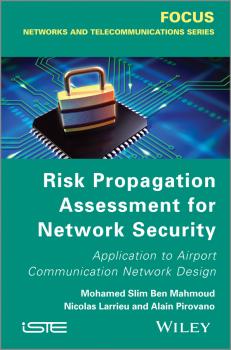Техническая литература
Различные книги в жанре Техническая литератураRisk Propagation Assessment for Network Security. Application to Airport Communication Network Design
The focus of this book is risk assessment methodologies for network architecture design. The main goal is to present and illustrate an innovative risk propagation-based quantitative assessment tool. This original approach aims to help network designers and security administrators to design and build more robust and secure network topologies. As an implementation case study, the authors consider an aeronautical network based on AeroMACS (Aeronautical Mobile Airport Communications System) technology. AeroMACS has been identified as the wireless access network for airport surface communications that will soon be deployed in European and American airports mainly for communications between aircraft and airlines. It is based on the IEEE 802.16-2009 standard, also known as WiMAX. The book begins with an introduction to the information system security risk management process, before moving on to present the different risk management methodologies that can be currently used (quantitative and qualitative). In the third part of the book, the authors’ original quantitative network risk assessment model based on risk propagation is introduced. Finally, a network case study of the future airport AeroMACS system is presented. This example illustrates how the authors’ quantitative risk assessment proposal can provide help to network security designers for the decision-making process and how the security of the entire network may thus be improved. Contents Part 1. Network Security Risk Assessment 1. Introduction to Information System Security Risk Management Process. 2. System Security Risk Management Background. 3. A Quantitative Network Risk Management Methodology Based on Risk Propagation. Part 2. Application to Airport Communication Network Design 4. The AeroMACS Communication System in the SESAR Project. 5. Aeronautical Network Case Study. About the Authors Mohamed Slim Ben Mahmoud is a research engineer for the research group ResCo at the TELECOM laboratory of ENAC, the French national institution for civil aviation. Nicolas Larrieu is a teacher and researcher at the research group ResCo at the TELECOM laboratory of ENAC. Alain Pirovano is a teacher and researcher and head of the research group ResCo at the TELECOM laboratory of ENAC.
Homeplug AV and IEEE 1901. A Handbook for PLC Designers and Users
The only authorized book explaining the HomePlug networking standards HomePlug is a growing technology for creating high-speed Power Line Communication (PLC) networks by transmitting data over in-home or in-office power lines. Users only need to plug adapters into wall outlets to create an instant network of computers, printers, routers, home entertainment devices, and appliance control systems. HomePlug AV and IEEE 1901: A Handbook for PLC Designers and Users provides for the first time an opportunity for non-members of the HomePlug Alliance to gain in-depth insight into the design and operation of the HomePlug standards. Offering a clear and simple description of the standards, this groundbreaking resource presents HomePlug AV and the associated IEEE 1901 standards in terms more readily understood by a much wider audience, including nontechnical managers, engineers, students, and HomePlug designers. The book details the many benefits of HomePlug AV, including: An affordable, secure alternative or complement to WiFi—especially in buildings where WiFi reception is poor or running new network wires is impractical Higher potential data transmission rates up to 200 Mbps Support for multimedia applications such as HDTV and VoIP The book also provides an overview of the HomePlug Green PHY standard that is targeted for use in smart energy applications, and the HomePlug AV 2.0 standard that operates at up to 1.5 Gbps. An essential tool for designers of HomePlug devices, network administrators, and individual users of HomePlug networks who need to understand the features and capabilities of HomePlug, HomePlug AV and IEEE 1901: A Handbook for PLC Designers and Users will also prove useful for researchers in academia and the power line communications industry.
Handbook of 3D Integration, Volume 3. 3D Process Technology
Edited by key figures in 3D integration and written by top authors from high-tech companies and renowned research institutions, this book covers the intricate details of 3D process technology. As such, the main focus is on silicon via formation, bonding and debonding, thinning, via reveal and backside processing, both from a technological and a materials science perspective. The last part of the book is concerned with assessing and enhancing the reliability of the 3D integrated devices, which is a prerequisite for the large-scale implementation of this emerging technology. Invaluable reading for materials scientists, semiconductor physicists, and those working in the semiconductor industry, as well as IT and electrical engineers.
MIMO-OFDM for LTE, WiFi and WiMAX. Coherent versus Non-coherent and Cooperative Turbo Transceivers
MIMO-OFDM for LTE, WIFI and WIMAX: Coherent versus Non-Coherent and Cooperative Turbo-Transceivers provides an up-to-date portrayal of wireless transmission based on OFDM techniques augmented with Space-Time Block Codes (STBCs) and Spatial-Division Multiple Access (SDMA). The volume also offers an in-depth treatment of cutting-edge Cooperative Communications. This monograph collates the latest techniques in a number of specific design areas of turbo-detected MIMO-OFDM wireless systems. As a result a wide range of topical subjects are examined, including channel coding and multiuser detection (MUD), with a special emphasis on optimum maximum-likelihood (ML) MUDs, reduced-complexity genetic algorithm aided near-ML MUDs and sphere detection. The benefits of spreading codes as well as joint iterative channel and data estimation are only a few of the radical new features of the book. Also considered are the benefits of turbo and LDPC channel coding, the entire suite of known joint coding and modulation schemes, space-time coding as well as SDM/SDMA MIMOs within the context of various application examples. The book systematically converts the lessons of Shannon's information theory into design principles applicable to practical wireless systems; the depth of discussions increases towards the end of the book. Discusses many state-of-the-art topics important to today's wireless communications engineers. Includes numerous complete system design examples for the industrial practitioner. Offers a detailed portrayal of sphere detection. Based on over twenty years of research into OFDM in the context of various applications, subsequently presenting comprehensive bibliographies.
Acid Mine Drainage, Rock Drainage, and Acid Sulfate Soils. Causes, Assessment, Prediction, Prevention, and Remediation
Provides the tools needed to analyze and solve acid drainage problems Featuring contributions from leading experts in science and engineering, this book explores the complex biogeochemistry of acid mine drainage, rock drainage, and acid sulfate soils. It describes how to predict, prevent, and remediate the environmental impact of acid drainage and the oxidation of sulfides, offering the latest sampling and analytical methods. Moreover, readers will discover new approaches for recovering valuable resources from acid mine drainage, including bioleaching. Acid Mine Drainage, Rock Drainage, and Acid Sulfate Soils reviews the most current findings in the field, offering new insights into the underlying causes as well as new tools to minimize the harm of acid drainage: Part I: Causes of Acid Mine Drainage, Rock Drainage and Sulfate Soils focuses on the biogeochemistry of acid drainage in different environments. Part II: Assessment of Acid Mine Drainage, Rock Drainage and Sulfate Soils covers stream characterization, aquatic and biological sampling, evaluation of aquatic resources, and some unusual aspects of sulfide oxidation. Part III: Prediction and Prevention of Acid Drainage discusses acid-base accounting, kinetic testing, block modeling, petrology, and mineralogy studies. It also explains relevant policy and regulations. Part IV: Remediation of Acid Drainage, Rock Drainage and Sulfate Soils examines both passive and active cleanup methods to remediate acid drainage. Case studies from a variety of geologic settings highlight various approaches to analyzing and solving acid drainage problems. Replete with helpful appendices and an extensive list of web resources, Acid Mine Drainage, Rock Drainage, and Acid Sulfate Soils is recommended for mining engineers and scientists, regulatory officials, environmental scientists, land developers, and students.
WiFi, WiMAX and LTE Multi-hop Mesh Networks. Basic Communication Protocols and Application Areas
Wifi, WiMAX, and Cellular Multihop Networks presents an overview of WiFi-based and WiMAX-based multihop relay networks. As the first text to cover IEEE 802.16j multihop hop relay technology, this revolutionary resource explores the latest advances in multi-hop and ad-hoc networking. Not only does this reference provide the technological aspects, but also the applications for the emerging technology and architectural issues. Ranging from introductory material to advanced topics, this guidebook is essential for engineers, researchers, and students interested in learning more about WiFi and WiMAX multihop relay networks.
Ближний Восток: Космос сегодня и завтра. Middle East: Space today and tomorrow
Идея написания данной книги возникла случайно, авторы не являются арабистами, но им интересен этот регион, поэтому было решено апробировать собственную методику оценки космической деятельности, на ее основе был разработан авторский прогноз тенденций развития космической деятельности стран Ближнего Востока на долгосрочную перспективу.Книга будет полезна специалистам по Ближнему Востоку, студентам, аспирантам, политикам, экономистам, военным и всем, кто интересуется Ближним Востоком и космосом.
Обобщенная оптимизационная задача производственно-транспортных процессов на предприятии
Данная статья содержит модель обобщения трех ранее известных задач линейного программирования: 1) производственной задачи (классическая постановка), решение которой представляет собой вектор количества произведенных конечных продуктов, найденный при ограничениях на количество ресурсов с учетом максимизации прибыли; 2) задачи учета времени, которую можно трактовать как дополнительное ограничение в общей системе ограничений и которая относится к целевой функции (минимизация затраченного суммарного времени на транспортировку груза); 3) транспортной задачи, решение которой определяет маршруты и объемы перевозок продукции на графе дорожной системы. Постановка задачи, объединяющей все три вышеперечисленные проблемы в одну комплексную, в точности подходит к случаю, когда стоит задача определения объема производства различных типов продукции с последующим определением маршрутов перевозок в каждый пункт потребления (потребителю) с целью минимизации с учетом пропускной способности графа дорожной сети транспортных издержек. Впервые задача была сформулирована для объектов лесоперерабатывающего комплекса в процессе производства и реализации товара. Настоящая статья посвящена построению линейной смешано-целочисленной модели и нахождению метода оптимального решения производственно-транспортной задачи. Такую задачу можно отнести к классу нетривиальных комбинаторных задач принятия решений на предприятии.
Синтез стохастического регулятора для вывода нелинейного дискретного объекта в заданное множество состояний
Автором рассматривается задача управления на многообразиях сложным (плохо формализуемым, нелинейным, с наличием неустойчивых состояний) объектом второго порядка, представленным в виде системы нелинейных разностных уравнений, правые части которых могут содержать неопределенности стохастической природы. Представлен алгоритм для аналитического конструирования закона управления, обеспечивающего стабилизацию исходной системы в окрестности заданного целевого множества. Дается информационная модель системы робастного управления на многообразиях, обусловленная двойственностью постановки задачи: стохастическим шумом измерительного типа и необходимостью корректного описания целевого множества. Приводятся результаты численного моделирования сконструированной системы управления для экономической балансовой модели.
Гибридное кибермоделирование в экономике: теория акторных сетей, симуляция, НЕ-факторы и сверхнечеткая логика
Компьютерное имитационное моделирование обычно заключается в запуске параллельных взаимодействующих вычислительных процессов, аналогичных реальным процессам, но в виртуальных пространствах и времени. Такая модель позволяет получать метрологические характеристики реального процесса, натурное исследование которого или очень дорого, или невозможно по причине риска получения невосполнимого ущерба. Однако для создания модели иногда нет полного набора исходных данных удовлетворительного уровня значимости, и создавать модель приходится в условиях неопределенности. В таком случае наряду с программами, получающими метрологические характеристики, возникает необходимость включать в модель программы, реализующие методы искусственного интеллекта для получения новых квалиметрических характеристик. В этом направлении идет развитие современных методов имитационного моделирования и соответствующего software.









